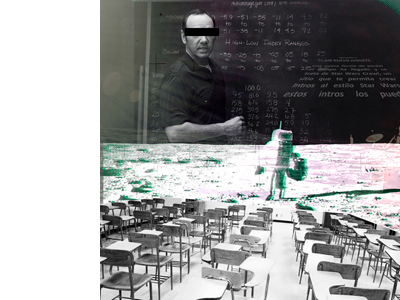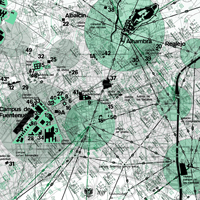You are in: Home page > Magazine Archive > Social Spaces of Learning

Rafael López-Toribio
Social Spaces of Learning
The case of ETSA in Granada

Collage: film still “21 black jack”+ American moon landing picture + classroom
Abstract
“Social Spaces of Learning” is an essay that aims to reflect on how the architecture should face the challenges that the new theories of education and certain needs (such as learning, establishing relationships, working, co-existing…) pose in the Granada School of Architecture and its historic surroundings, El Realejo. To do this, it’s necessary to analyse physical and social realities providing support to new teaching-learning models. This project points out spaces of opportunity to put into practice actions designed to favour the integration and relationship between the city and the university.
Text
“The illiterate of the 21st century will not be those who cannot read and write, but those who cannot learn, unlearn, and relearn.”
Alvin Toffler (paraphrasing H. Gerjuoy) [1]
The development of the Internet can be identified as a catalyst or trigger for the transition from an industrial to an informational society. It is thus a fact that the arrival of the digital age has completely transformed the physical world, or at least the way we are in it. As for education and learning, this change has caused the traditional educational institutions to losetheir exclusivity on the production and transmission of knowledge. For the first time ever, free access to information will offer the majority of people the chance to build and shape their own learning landscape. In the words of M. Serres, knowledge “has escaped” beyond the limits of the educational institutions. [2]
This fact makes us to consider the role of traditional educational institutions in the current learning context. Does the existence of these institutions as we know and understand them nowadays make any sense?
It is essential to question the axioms on which, up till now, the learning spaces are based: on the one hand, the nature, configuration and connection of official or institutional places (college, classroom, auditorium, workshop...) with the environment; on the other hand, we have to analyse the function of those spaces which have contributed to the informal learning process (corridor, patio, café, public space,…)
Colleges have to redefine their role, not only as spaces of informal education, but as spaces capable of attracting and activating synergies that provide new teaching and learning methods. Colleges no longer have the exclusive rights on the educational process. That means colleges would now be centrality nodes in a learning network dissolved in the city itself; spaces of meeting and relationship between individuals.
Nowadays, the limits of the learning would change depending on the perspective from which they are approached. Although digital tools encourage the overflow of the learning processes beyond the institutions; from a physical point of view, educational environment is presented as a scenario with rigid, sharply defined outlines and boundaries, forming as a result of two pretty differentiated areas: “indoors” and “outdoors”.
“Indoors” is considered as an area where we assume that teaching and learning process takes place; an area in which the educational institutions are laid down; traditional learning environments; spaces in which what happens is the result of a script already written or predictable. “Outdoors”, as a space that encourages indeterminacy, spontaneity, exploration; that is, the area to which a closed educational environment could be extended.
How could we overcome this situation? Which interface could allow the overflow of learning to also take place in a physical sense? The answer would be the city. Urban dynamics can provide a lot of possibilities of reflection on the new learning situations and spaces; maybe through the infection between the inside and outside, acquiring each other’s characteristics that will enrich them.
In certain spaces and times, could “inside” acquire the characteristics of the “outside” environment? Do certain places in the school have characteristics leading to indeterminacy and spontaneity? Is there any space in the city that can be used to perform teaching and learning activities, whether it is in a private or public space? Could “satellite” spaces where we can learn exist?
According to the architect and theorist Herman Hertzberger [3], “the city is the best school”. In order to do this, urban space must take the role of “macro-classroom” by establishing a paradigm of Space for Education. Following this line of thought, as well as urban experiences such as the experiment carried out at the University of Oregon by Christopher Alexander [4],“Urbanismo y Participación. El caso de la Universidad de Oregón” (“Urban Development and Participation. Oregon Experiment”), the modern city is considered as the essential setting for a comprehensible education for the citizens.
From a SPATIAL point of view, the university can be understood as a subsystem that is part of a more important system, the city. They usually connect to each other in two fundamental ways:
- Through the isolated campus, located in an outlying area of the city. It has certain degree of autonomy in relation to the urban fabric. Its connections are usually linked to mobility infrastructures that solve medium and long distance movements.
- Through the urban campus, or dispersed. In this case, the buildings shaping the campus itself (on their own or altogether) are inserted into the urban scene. In this sense, its connection with the environment is more emphatic, more understanding, with a neighborhood structure. This is the case of the Higher Technical School of the University of Granada (E.T.S.A.G.) and its historic environment, El Realejo, located in the city center.
The improvement of the relationship and interaction between the city and the university implies a reflection on these two variants: spatial and social perspectives. In other words, we have to search for a series of mechanisms and catalysts that serve as hinges between the two systems, encouraging in this way the meeting and interaction. SOCIAL SPACES OF LEARNING.In the case of the E.T.S.A.G. and El Realejo, obtaining these environments is linked to the ability to create ideal conditions in already existing places, both at school and the neighborhood, that, currently, don’t have any specific use because of their marginal condition (in the margin). However, this same condition makes possible to activate synergies that encourage the meeting between people, since they are located in the “between” of the imaginary collective. They don’t belong to “inside” or “outside” (corridors, patios, transit areas, entrances, public spaces, local places…)
Considering that the contemporary teaching and learning processes can take place in any location, using these spaces is a very valuable opportunity for the heterogeneous meeting of people or groups of people. Virtual support, although it favours the connectivity, often generates an individualization of work (monitor and individual). The architecture of the educational institutions must promote environments aimed at community and exchange of ideas in a physical reality.
These spaces should seek to create warm and welcoming atmospheres. The capacity to attract and engage diverse communities is essential in order to break the physical and mental barriers between them. A recurring example is the freedom and natural spontaneity of game in children. Anthropologists and architects (Aldo Van Eyck) have thought about the interaction between the children and places to game. Children’s behaviors are characterized by spontaneity, interaction, erratic movements and creative use of the environment. Maybe it’s the time to consider the learning process as an enjoyable game rather than an imposition. Quoting Einstein [5], learning “should be such that what is offered is perceived as a valuable gift and not as a hard duty”. This scientist invited us to learn pursuing the pleasure.
Digital age opens up possibilities for designing an own learning map that places us in a collective learning environment across institutions and beyond institutional walls. From the physical perspective, this interface would be the city. The city, as a complex entity, offers infinite learning opportunities, from an informal learning (not institutionalized and unscheduled educational proposals) to a formal learning (or institutional). City can hold and create ambiguous situations that coordinate formal and informal learning and this is, possibly, one of its greatest potentials: the city as a gameboard in a learning process. The city has to be the school and the school has to be the city.
Note
[1] A. Toffler paraphrasing H. Gerjuoy in the article The Future as a Way of Life, Horizon magazine, Summer 1965
[2] M. Serres, Pulgarcita, Manifiestos le Pommier, de la Academia Francesa, París, 2012, pp 7- 22.
[3] H. Hertzberger, Spaces and Learning, 010 Publishers, Rotterdam, 2008, relating to chapter 4, pp 202-253
[4] C. Alexander, Urbanismo y Participación. El caso de la Universidad de Oregón, Gustavo Gili, Barcelona, 1976, pp 30-46
[5]Reflection of Albert Einstein in the collected text by,The Human Side. New Glimpses from his Archives, Princeton University Press, 1979
Bibliography:
PhD thesis R. Lopez-Toribio, Espacios Sociales de Aprendizaje. Caso Especício de la E.T.S.A.G. en el Barrio de El Realejo, Granada, 2015
A. Toffler, The Future as a Way of Life, Horizon magazine, Summer 1965
M. Serres, Pulgarcita, Manifiestos le Pommier, de la Academia Francesa, París, 2012
R. Díaz, ¿Y si la educación puede suceder en cualquier momento y en cualquier lugar?, en Educación Expandida, Zemos 98, 2009
H. Hertzberger, Spaces and Learning, 010 Publishers, Rotterdam, 2008
P. Calvo-Sotelo, Espacios innovadores para la excelencia universitaria: estudio de paradigmas de optimización docente y adaptación al Espacio Europeo de Educación Superior, Ministerio de Educación, Universidad San Pablo, 2010
Asociación Internacional de Ciudades Educadoras, Carta de la Ciudad Educadora (revisada en 2004 Génova,). [Fecha de consulta agosto de 2015]. Disponibile in: http://www.bcn.cat/edcities/aice/estatiques/espanyol/sec_charter.html
C. Alexander, Urbanismo y Participación. El caso de la Universidad de Oregón, Gustavo Gili, Barcelona, 1976
A. Den Heijer, in your article Campus of the future: to share or not to be, in the Program Campus de Excelencia Internacional (Conferencia Internacional sobre Espacios Sociales de Aprendizaje), Ministerio de Educación, Barcellona, 2011
Texts by A. van Eyck in V. Ligtelijn e F. Strauven (edited by), Writings: vol. 1: The Child, the City and the Artist, Sun Publishers, The Netherlands, 2006
Rafael López-Toribio is an architecture student at the Granada School. He has collaborated with the “Department of Urban and Regional Planning” at the University of Granada. He has participated in research projects such as "Cultural Routes of Granada Urban Heritage" CEI Biotic. He currently works at the” Delegation of Architecture, Housing and Land” of Development Ministry in Madrid.














